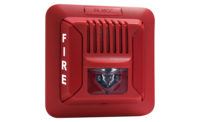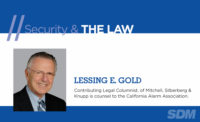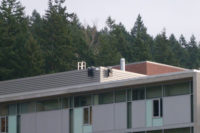Security dealers will need to rethink their decisions about certain fire alarm notification appliances as the result of new code changes. Audio output devices are the ones primarily impacted by the code changes, but some requirements also impact visual outputs.
SOUNDERS FOR SLEEPING QUARTERS
The 2010 and 2013 versions of the National Fire Alarm and Signaling Code from the National Fire Protection Association, known as NFPA 72, have a new requirement for sleeping areas in new installations in commercial buildings that is scheduled to kick in Jan. 1, 2014, explains Lee Richardson, senior electrical engineer for the NFPA.
In those installations, dealers now will have to install low-frequency sounding devices that use 520 Hz square waveforms or produce an equivalent sound, explains Rodger Reiswig, director of industry relations for Westminster, Mass.-based fire systems integrator SimplexGrinnell. The new requirement was triggered by research conducted by the NFPA’s Fire Analysis and Research division, which determined that these lower-frequency sounders did a better job of waking people who are hearing or alcohol impaired than the higher-frequency sounders that have been used to date.
Not every local jurisdiction has adopted the 2010 or 2013 version of NFPA72. But the number of jurisdictions that have is on the rise — and more will be added moving forward.
To meet the new low-frequency requirements, manufacturers have had to rethink the piezoelectric sounders traditionally used with fire alarm systems, which typically operate in the range of 3000 Hz, explains Roopa Shortt, audio visual marketing manager for St. Charles, Ill.-based fire equipment manufacturer System Sensor. Shortt notes that System Sensor has developed a device that uses speaker technology rather than piezoelectric technology to produce a 520 Hz tone. Minimizing the size of the product was particularly challenging, she said, noting that a 520 Hz tone is similar to the sound put out by the large base speakers built into home stereo systems.
Reiswig notes another alternative to using sounders designed specifically to work at 520 Hz. As he explains, SimplexGrinnell uses a fire panel that has an amplifier and sound player that can send a signal to a speaker to enable it to produce the appropriate 520 Hz tone.
Another option, Richardson says, is to use an appliance that listens for the traditional fire alarm speaker tone and then outputs the appropriate low-frequency tone. He notes that some dealers may already have been using these devices to meet a requirement that is already in effect in some jurisdictions for residential installations.
As Richardson, explains, the 2010 and 2013 versions of NFPA72 require the use of the lower-frequency sounders in residential installations for quarters where people with hearing impairments are known to sleep. That requirement doesn’t share the January 2014 implementation date but instead takes effect as soon as a jurisdiction adopts either the 2010 or 2013 version of the standard.
MASS NOTIFICATION
Another important development involving fire alarm notification appliances is the increasing popularity of mass notification systems. Currently mass notification is only required for certain types of government installations, such as locations that must comply with Department of Defense requirements. But some jurisdictions are beginning to require mass notification systems for certain types of installations, such as schools. And some customers are beginning to voluntarily install mass notification systems in the wake of several high-profile acts of massive violence such as the shootings that occurred at a public school in Newtown, Conn.
“Even though it’s optional, it’s an explosive market lately,” comments Larry Mann, project manager for Birmingham, Ala.-based Central Station Inc. and a member of the industry committee that helps shape NFPA72 standards.
The NFPA codes leave it to local authorities to determine where mass notification systems are required. But where local authorities do impose such requirements, the latest versions of the NFPA codes detail a range of requirements for those systems — and some of those requirements impact the notification appliances connected to the systems.
“Instead of horns you have speakers,” observes Bryan McLane, vice president for the National Training Center, a Las Vegas-based company specializing in fire system training.
As McLane notes, mass notification was first discussed in the 2007 version of NFPA72. Each successive version — 2010 and 2013 — added more detail.
A key element of the new mass notification requirements is what the standards call “emergency voice communications,” McLane explains. These systems are similar to the voice evacuation systems that have been used for years in some fire installations. But while those systems were designed especially to help evacuate occupants from a building, evacuation isn’t the appropriate response for all types of emergencies. McLane cites the example of a chemical spill outside of a building, where people would be advised to stay inside.
Emergency voice communications systems designed for mass notification can be triggered by a wide range of events and can have pre-recorded messages tailored for each type of event. For example, a tornado warning from a national weather service feed could trigger the playing of a voice message advising people to take cover. Such systems also may have the ability for security personnel to speak into a microphone for broadcast through speakers in appropriate areas.
The 2010 and 2013 versions of the NFPA72 code also require speakers used with emergency voice communications systems, including systems used with commercial fire systems and with mass notification systems, to be “intelligible.”
The NFPA codes leave it to local authorities to establish intelligibility requirements but recommends that authorities use intelligibility measurement scales such as the common intelligibility scale (CIS) and the speech transmission index (STI). While earlier versions of the NFPA code specified where speakers should be placed for sufficient volume, it’s now up to installing companies to determine the correct speaker placement for specific installations. Intelligibility requirements have turned emergency voice communications systems into engineered systems.
Although the 2010 and 2013 versions of NFPA72 are quite similar with regard to intelligibility requirements, the 2013 version has more stringent documentation requirements, notes Richardson. Keeping a record of performance measurements at the time of installation establishes a baseline for future testing, he explains, adding that this is something designers should have been doing all along.
Richardson also notes that the 2013 version of NFPA72 also adds a requirement for documentation that the alert lights used in new systems meet visibility requirements at the time of installation.
MASS NOTIFICATION STROBES
Mass notification systems have different strobe requirements than traditional fire systems. For years fire systems have used strobes with clear lenses that are marked “fire.”
But as McLane explains, “For mass notification you can’t use those. . . It has to say ‘alert,’ not ‘fire.’” To further differentiate non-fire alerts, several manufacturers are moving to an amber or yellow strobe for non-fire emergencies — although according to McLane, some other colors also could be used there.
McLane believes customers whose fire systems require a voice evacuation system should seriously consider installing a system that can meet mass evacuation requirements as well, as the main difference between the two types of systems now is the requirement for the additional strobes. He points to the example of a school with more than 50 occupants that would be required by the 2012 version of the International Building Code to have voice evacuation capability. For a bit more investment the school could also have mass evacuation capability.
Reiswig notes that SimplexGrinnell has seen a “very big upswing of engagement when it comes to mass notification” on the part of schools and universities. “If anything little thing happens at a college or university, it makes the news.”
The move toward mass notification has changed the sales process for SimplexGrinnell, Reiswig observes. Traditionally fire system sales have been virtually 100 percent code-driven. But with mass notification, Reiswig says, “You have to have the right mindset to sit down and ask ‘How will first responders come in and how can our equipment help them?’”
Depending on the circumstances, mass notification systems also may use other means — for example text messages or electronic signage — to notify people about an emergency. As Reiswig explains, a customer planning a mass notification system should first do a risk assessment to determine what types of emergencies should be planned for and what the appropriate action should be in the event of each type of emergency.
Researchers Explore Strobe Visibility
Further changes could be ahead for the visual side of the fire notification appliances. At press time in July, the Fire Protection Research Foundation was expected soon to release the results of testing aimed at evaluating the effectiveness of existing standards for visible notification.
The new research draws on previous research which suggested that “effective intensity may not be predictive of visual detection of signal lights when these are viewed indirectly or in the far-peripheral field of view,” the research foundation explains in a summary document about the new research. The research foundation was concerned about people who cannot directly view an emergency light alert but instead can only see the change in illuminance on room surfaces.
The previous foundation study suggested that a flashing light should increase the illuminance on the opposite wall by at least 7 percent in order for the increase to be reliably detected. The new research aims to determine whether the 7 percent increase in light level can be “reliably detected by observers with normal vision.”
The new research was triggered, in part, by the development of fire notification lights that use LED rather than traditional strobe technology, the research foundation notes in the summary document.
“There are a lot of issues that the industry has to understand yet on how to get the attention of people with strobe lighting,” comments Ted Milburn, vice president of marketing for Cooper Notification, a Sarasota, Fla.-based manufacturer of fire alert lighting that uses LEDs that self-adjust depending on the conditions in a room.
More information about the Fire Protection Research Foundation’s anticipated research on visible notification for fire systems can be found on the foundation’s website: http://www.nfpa.org/research/fire-protection-research-foundation.
MORE ONLINE
Readers can find additional information about fire alarm notification appliances in previous SDM coverage available on www.SDMmag.com.
Intelligibility for fire and mass notification systems was covered in September 2012:
www.SDMmag.com/intelligibility-for-life-safety
Mass notification standards were covered in May 2013:
and December 2012: www.SDMmag.com/fire-panels
Various NFPA72 initiatives are highlighted in this July 2012 article: www.SDMmag.com/action-on-nfpa-72







